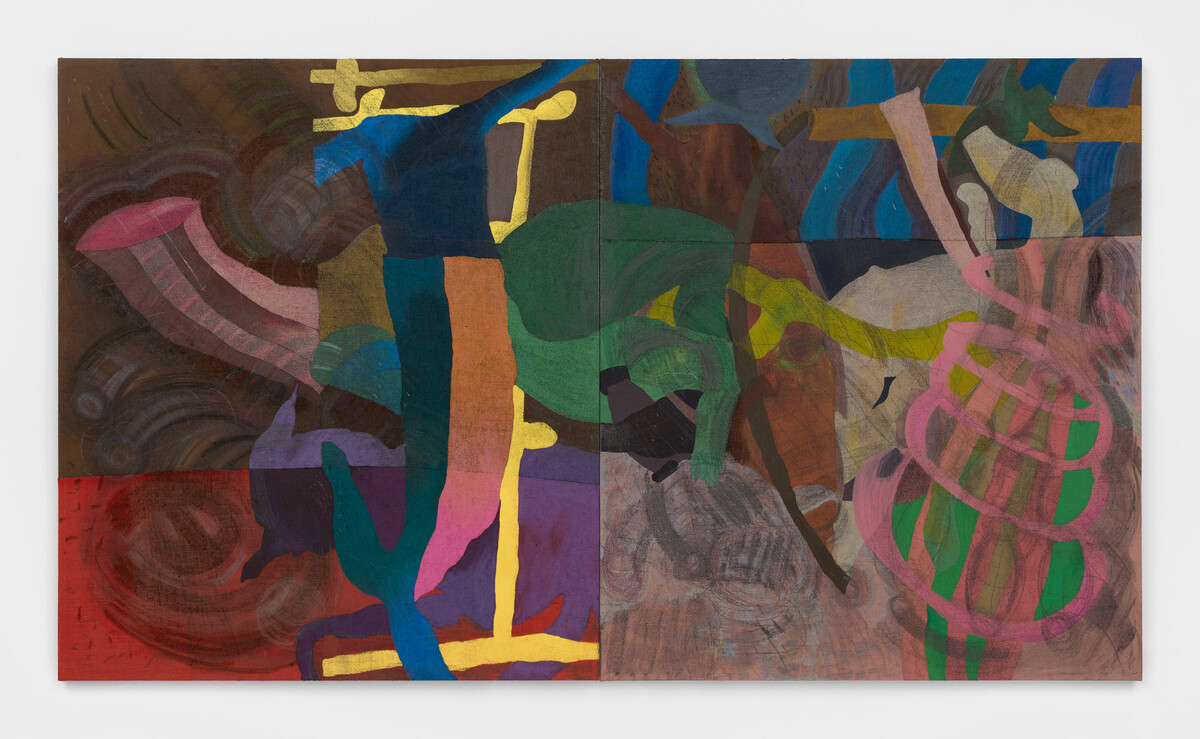
Kaveri Raina, the kingdom, the cave, the beginning; and the ant taking over, 2024, Acrylic, graphite, oil pastel, burlap, 75 x 130” / 190.5 x 330.2cm. Photo: Dan Bradica Studio
Kaveri Raina’s first solo exhibition at Casey Kaplan, reflection as a witness, reveals the fractured narratives of an unseen world. Rendered in acrylic, oil pastel, and graphite on pigmented burlap, Raina’s paintings form submerged kingdoms, composed of heroic tales from the past and scattered records gleaned from memories of the artist’s shifting environments.
Raina’s references are both illuminating and tragic, intersecting her own somatic experiences with legends of warriors and stories of conflict. Through memory’s ability to dissect disaster, Raina paints the lingering presence of violence. Perceptions hidden within the body, like the enveloping embrace of water or the search for light in a dark room, are deeply embedded into her painting process. Combining abstraction and figuration, Raina fragments her own recollections of inherited histories, crafting scenes that commemorate the wake of disaster and nurture the richness of life.
In reflection as a witness, the kingdom becomes a collaged world of past tales and imagined tableaux, providing Raina a space to witness everything as it unfolds. Expanding on a work exhibited earlier this year, the kingdom, the cave, the beginning, and the sun shining through the haystacks (2024), Raina introduces two monumental new paintings, the kingdom, the cave, the beginning; and the ant taking over (2024) and the kingdom, the cave, the beginning; and yet the heart prevails (2024), which the artist refers to as the “pillars” of a series of sunken realms. Constructed from adjoining, boldly pigmented panels of sewn and stretched burlap, they feature participants from previous works alongside an evolution of new forms. A headless mermaid is accompanied by an angular yellow figure alongside a cocoon-shaped form (referred to by the artist as an ant), unfolding and expanding like a valve.
Other paintings serve as complementary pillars, showcasing their own progression of characters, each evolving with the mood of the scene. The large vessels in deepest blue, and yet we follow the wind (2024) and frenzied, invisible jacket of burn hovering between us (2024), emerge like excavated bodies or passageways. Separated by seams in the burlap, figures undulate within the kingdom—some floating above, others sinking below, engulfed by water or earth. Raina is pulled towards the intensity of turmoil, containing its heaviness within the bounds of her burlap surfaces. Swirling gestures of graphite and oil pastel simulate turbulent weather and the constant motion of underwater life. Bodies materialize from deep pools of paint, appearing ruptured like unset bones.
During her time as a student at the School of the Art Institute of Chicago, Raina first encountered the paintings of Leon Golub (1922–2004). She was captivated by their raw presence and has repeatedly drawn from Golub’s scenes of conflict. The boxed structures in several of Raina’s paintings, most notably in floating freely; privilege of being looked at (2024), have become a familiar framing technique, with their conceptual origins tied to Golub’s painting White Squad IV (El Salvador), 1983. Raina translates his depiction of a body encased within the cavity of a car trunk into an ongoing abstraction of a coffin-like space, rendering figures in rich hues of acrylic, extending from and falling into a frame—possibly levitating between realms. Lee Lozano’s (1930–1999) tool paintings and drawings have also been instrumental for the artist. Like Lozano, Raina elevates these everyday objects to a monumental scale, transforming them into symbols of productivity or potential destruction. Forms resembling hammers and scissors elongate and curve like limbs, coalescing with other bodies. Like memory’s silent rupture or anger surfacing within the body, Raina’s kingdoms bear the weight of a complex past.
